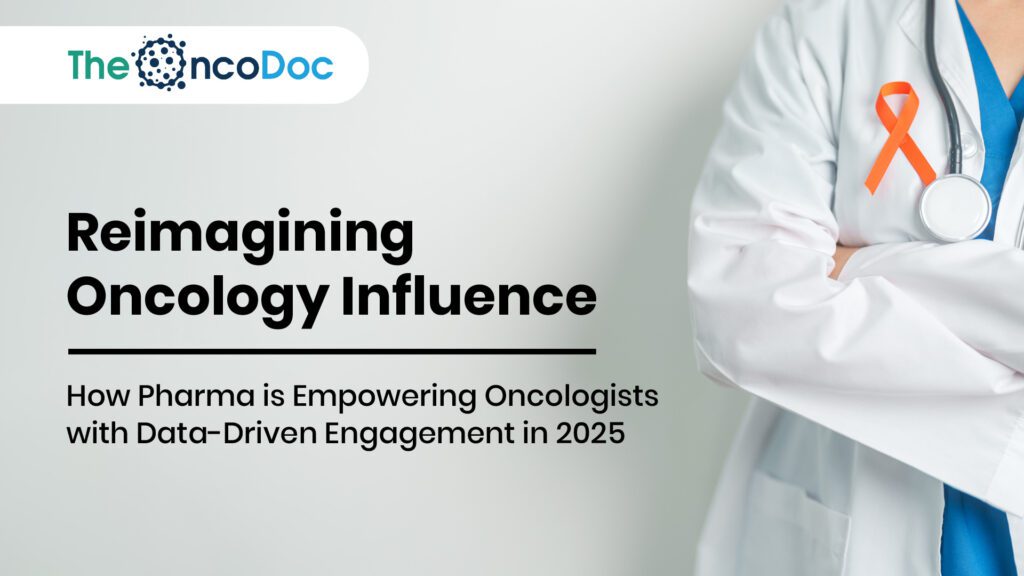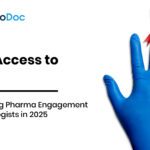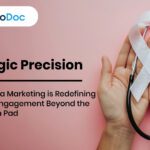Introduction: The Oncology Influencer is Now a Data Navigator
In 2025, Indian oncologists stand at the confluence of clinical overload and a rapidly evolving treatment landscape. They no longer simply prescribe drugs-they interpret next-generation sequencing (NGS) reports, compare biosimilars, navigate global guidelines, and manage high patient volumes daily. To support them, pharma marketing has shifted from generic messaging to highly tailored, data-driven education that adds value without adding time.
This is not marketing as usual-it is marketing as clinical empowerment.
1. The Shifting Identity of the Indian Oncologist
Today’s oncologists, particularly in India, must make critical, rapid decisions with incomplete information and high patient expectations. They manage anywhere between 50 to 100 oncology consults a week. For pharma marketers, this means abandoning the old “push product” mentality. Instead, pharma must become a resource for clarity in complexity.
Pharma brands are now adopting “digital empathy”-building outreach that fits into tight schedules, respects the need for brevity, and enriches knowledge without overwhelming. The tone of modern engagement is not promotional, but consultative.
2. The Digital Detailing Revolution: Personalizing Every Interaction
AI-powered detailing tools have changed the game. Instead of one-size-fits-all slide decks, pharma reps now use tablets loaded with personalized dashboards.
These dashboards adjust in real time depending on:
- The tumor focus of the oncologist (e.g., lung vs colorectal)
- Past interactions and interests
- Prescribing behavior across biosimilars or newer targeted therapies
- Language preference and region-specific epidemiology
Examples:
- If an oncologist recently attended a CME on triple-negative breast cancer (TNBC), their next interaction includes a quick update on a new antibody-drug conjugate (ADC).
- A dashboard may also suggest new patient assistance programs tailored for their practice’s district.
This strategy ensures each minute with the oncologist is clinically meaningful, not marketing filler.
3. Bar Chart: Preferred Format for Oncology Information Among Indian Oncologists (2025 Survey)
Insight: The modern oncologist prefers on-demand, interactive formats that allow asynchronous learning. Physical brochures are nearly obsolete. If it’s not mobile-optimized, it’s not consumed.
4. Precision Segmentation: Oncologists Are Not One Audience
With AI tools, pharma marketers can now segment oncologists based on more than just specialty. They analyze practice geography, prescribing behavior, CME participation, and even digital literacy to form nuanced personas.
Segmentation Criteria Examples:
- Dr. A is a surgical oncologist in Lucknow who prefers Hindi language updates
- Dr. B is a GI medical oncologist in Delhi with a keen interest in biosimilar trials.
- Dr. C is a community oncologist in Coimbatore who frequently uses WhatsApp CME modules.
This allows pharma to send different formats, tones, and even content timing for maximum engagement, increasing relevancy and ROI.
5. Local Language, Clinical Depth: A Delicate Balance
Pharma marketing often faces a dilemma: keep content medically accurate or make it widely accessible? AI now bridges this gap by auto-translating scientific content into 12+ Indian languages while retaining technical precision.
Examples of localized content:
- Bengali explainer videos for rural oncology camps
- Tamil WhatsApp nudges summarizing trial updates
- Marathi voice bots handling FAQs about immunotherapy dosing
This linguistic reach boosts trust, understanding, and content sharing, especially among Tier 2 and 3 oncologists.
6. The CME Reimagined: Short, Smart, and Specialist-Led
Traditional CME (Continuing Medical Education) formats were long, location-bound, and had limited reach. The modern CME is:
- Short (5–15 minutes)
- Mobile-based
- Case-based
Pharma brands now create interactive journeys where oncologists can:
- Diagnose virtual patients
- Compare treatment plans
- Receive CME credits instantly
🎯 These micro-CMEs are also platform-agnostic: delivered via apps, WhatsApp, or even SMS-based quiz systems.
7.Most Valued CME Formats Among Oncologists in Tier 1 Cities (2025)
Key Insight: Case-based simulations are dominating Tier 1 cities, while WhatsApp learning is seeing faster adoption in Tier 2/3 due to accessibility.
8. Peer-Led Influence: KOLs Meet Micro-Mentors
Pharma’s reliance on a few high-profile Key Opinion Leaders (KOLs) is shifting. Today’s micro-KOLs may be junior oncologists, but their posts go viral in closed HCP WhatsApp groups or Facebook communities.
AI tools now help identify:
- Top-shared oncology voices in local forums
- Influencers in vernacular language spaces
- Those with high referral impact despite low social presence
Pharma brands now co-create content with these voices:
- Regional reels with actionable tips
- Case debates via Instagram Liv
- 1-slide summary explainers hosted on Telegram
This authenticity drives trust far more than traditional podium talks.
9. Real-Time Analytics: Marketing That Learns and Adapts
Each campaign, once launched, is now continuously optimized by AI.
Analytics Tracked:
- When content is opened (pre-clinic vs post-clinic hours)
- Which specialties click through vs skip
- What common follow-up questions are being asked
If a PDF has low open rates but the same content in a 60-second reel performs better, the system adapts.
Pharma no longer waits for quarterly feedback-content adapts daily, improving efficiency and HCP satisfaction.
10. The Oncology Newsletter, Reinvented
Newsletters were once long, static, and seldom read. In 2025, they are dynamic and personalized.
Each oncologist receives:
- A concise top 3 research snippet feed
- Drug updates only for indications they manage
- Embedded calendar links for specialty webinars
- Patient aid news specific to their city
Example: A breast oncologist in Jaipur receives a 2-minute audio brief summarizing ASCO highlights on CDK4/6 inhibitors, in Hindi, with embedded links to visual abstracts.
11. Channels Through Which Oncologists Prefer Brand Updates (2025)
Observation: WhatsApp leads due to convenience, low bandwidth, and familiarity. Brands sticking only to email risk invisibility.
12. Content as Utility: Not Just Brand Promotion
Today’s most successful pharma campaigns don’t lead with brand, they lead with clinical utility.
Examples:
- A breast cancer treatment flowchart download
- A pre-chemo checklist for patient caregivers
- A chemotherapy side effect diary printable
Such tools are immediately useful, earn attention, and create goodwill. Once trust is built, brand messages are far more likely to be received and remembered.
13. Disease Awareness to Therapy Awareness: Building Continuity
Most pharma campaigns focus either on disease (awareness) or drugs (promotion). But modern marketing creates content continuity.
Journey-Based Campaign Structure:
- Awareness: “Why prolonged cough could be a red flag”
- Diagnostic Prompt: “Ask for a low-dose CT”
- Therapy Education: “Latest regimens for Stage II NSCLC
- Adherence Support: “Managing fatigue during immunotherapy”
- Survivor Reintegration: “Returning to work after lung cancer”
🎯 The content isn’t siloed-it builds a complete ecosystem around the disease and treatment lifecycle.
14. WhatsApp in Oncology: India’s Most Underutilized Pharma Channel
Despite being widely used for clinical discussions, pharma marketers rarely use WhatsApp strategically.
Now, with AI-driven CRM platforms, pharma teams can:
- Auto-schedule sequenced learning journeys
- Collect feedback in chat format
- Send CME invites with RSVP tracking
Example:
An oncologist receives a daily case snippet: “Male, 48, non-smoker, ALK+ NSCLC, 2nd-line?” and clicks to vote. Based on this, they’re sent the latest ALK inhibitor comparison table in under 20 seconds.
15. Empowering Tumor Boards with Digital Tools
Tumor boards are the nerve centers of oncology decision-making. Pharma marketing is evolving into decision-support marketing.
Digital Empowerment Tools:
- Slide templates with trial data
- Prognostic scoring calculators
- Mobile-accessible NCCN/EANO pathways
This gives the pharma brand a seat at the table without selling-just supporting evidence-based discussions.
16. From Detailers to Data Translators: The MR’s Role Redefined
MRs are now trained in data interpretation, not just brand detailing. With AI dashboards, they show insights like:
- “In South India, this molecule improved DFS by 12% in real-world use”
- “Here’s how your peers are managing chemo brain symptoms”
This builds clinical credibility and improves MR access to high-volume oncologists who otherwise skip in-person meetings.
17. Clinical Trials: Inclusion Marketing Done Right
Clinical trial diversity has become a focal point for regulators and sponsors alike. Yet, many oncologists in Tier 2/3 cities in India feel disconnected from trial ecosystems. They lack the logistical support, awareness of ongoing studies, or access to tech platforms.
Pharma marketers are now using AI to map trial feasibility based on:
- Investigator specialty
- Number of eligible patients
- Proximity to trial labs or diagnostic centers
- Past trial participation history
💡 Tactical Execution:
- Micro-sites for oncologists that auto-match active trials by indication
- WhatsApp bots that let doctors enroll patients using voice-guided consent
- Local CME modules on “How to conduct your first trial” with CRO partners
🎯 Result: Pharma expands its trial footprint ethically, builds goodwill, and boosts drug visibility in pre-launch phases-transforming marketers into enablers of research access.
18. Emotional Intelligence + Oncology Marketing
Cancer is more than a diagnosis-it’s a life rupture. Emotional intelligence in pharma campaigns doesn’t just humanize the brand; it helps oncologists connect more deeply with their patients.
🧠 Modern Tactics:
- Animated survivor testimonials in local languages, co-hosted by physicians
- Video vignettes where caregivers talk about overcoming treatment fear
- Reels combining clinical guidance with community resilience stories
Why it works:
- Stories create memorability. Doctors remember the molecule and the message.
- Relatable content increases sharing. Oncologists are more likely to forward regional success stories to peers or patients.
- Emotion builds recall. Data wrapped in emotion sticks longer than raw detailers.
Pharma messaging that engages both clinical and emotional IQ is more likely to drive meaningful engagement.
19. Real-Time Feedback Loops with Oncologists
Modern pharma marketing doesn’t end with distribution-it begins there. AI tools now allow marketers to embed lightweight feedback loops within every content touchpoint.
Examples of feedback mechanisms:
- “Was this case summary helpful?” one-tap poll after WhatsApp delivery
- NPS-style ratings after a CME event (“Would you recommend this to peers?”
- Chatbot surveys that ask: “Do you need more content on RCC or prostate cancer?”
These inputs feed into dashboards, helping marketers:
- Identify what topics resonate
- Spot regional gaps in comprehension or interest
- Adjust tone (e.g., too technical vs too simplified)
📈 Outcome: Oncologist sentiment becomes a KPI. Pharma can act not just based on consumption-but on perceived value.
20. The Rise of the “Always-On” Oncology CRM
CRM (Customer Relationship Management) in pharma has evolved beyond Salesforce-based tracking of MR visits. AI-enabled CRM platforms now act as 24/7 interaction hubs, adapting dynamically to each oncologist’s preferences, case load, and interests.
Modern CRM Features:
- Behavioral sequencing: “Dr. G clicked a liver cancer article → next send trial update”
- Smart timing: “Avoid outreach between 2–6 PM in OPD-heavy hospitals”
- Multichannel presence: auto-synced outreach via WhatsApp, LinkedIn, email
Example Use Case:
An oncologist in Pune who engages frequently with biosimilar updates receives a monthly digest of peer-reviewed summaries, access to a reimbursement helpline, and an invite to a biosimilar-focused tumor board-all without a single MR visit.
📌 Why it matters: Pharma becomes a silent clinical assistant, always available, never intrusive.
Conclusion: The Future of Pharma Marketing Is Oncologist-First
This new era of oncology marketing is driven by data fluency, empathy, and agility. Oncologists no longer tolerate interruptions-they reward insight, relevance, and utility.
- Summary of Winning Pharma Strategies:
| Principle | Application |
| Data Personalization | AI dashboards, EMR-linked nudges |
| Content as Utility | Flowcharts, protocols, CME kits |
| Language and Emotion | Survivor stories, localized tools |
| Channel Intelligence | WhatsApp, voice bots, mobile-first |
| Clinical Empowerment | Peer-to-peer explainers, trial access |
In 2025 and beyond, the pharma marketer who understands the oncologist’s reality-and builds marketing that fits seamlessly into it-won’t just increase brand recall.
They’ll become part of the therapeutic ecosystem itself.
Because in oncology, you don’t just market the molecule-you support the mission.
The Oncodoc team is a group of passionate healthcare and marketing professionals dedicated to delivering accurate, engaging, and impactful content. With expertise across medical research, digital strategy, and clinical communication, the team focuses on empowering healthcare professionals and patients alike. Through evidence-based insights and innovative storytelling, Hidoc aims to bridge the gap between medicine and digital engagement, promoting wellness and informed decision-making.



